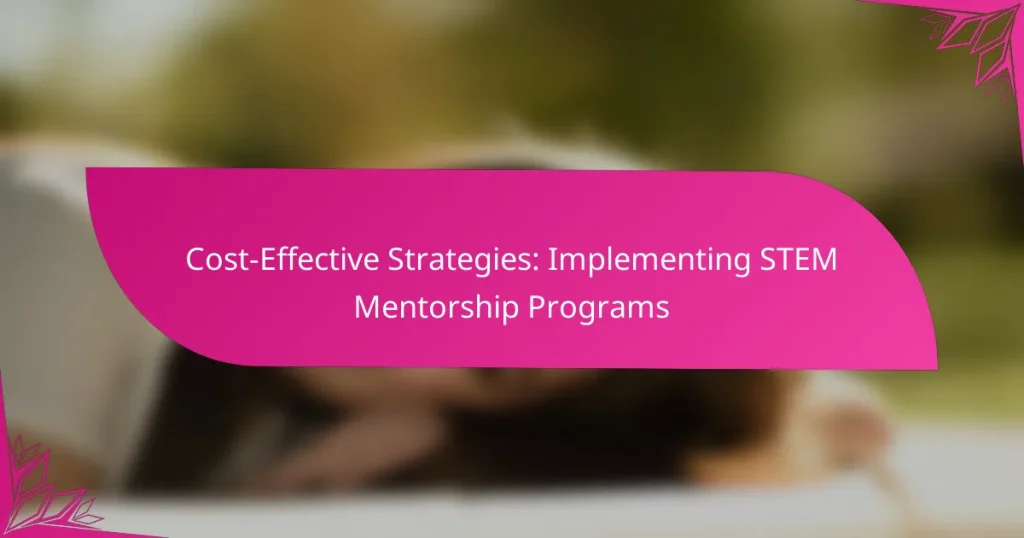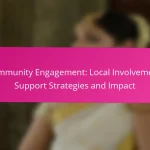Implementing cost-effective STEM mentorship programs is essential for fostering the next generation of innovators while maximizing available resources. By utilizing virtual platforms and collaborating with local universities and community organizations, these programs can provide valuable guidance and real-world experiences to students without incurring significant expenses. Ultimately, these initiatives enhance student engagement and career readiness in the fields of science, technology, engineering, and mathematics.
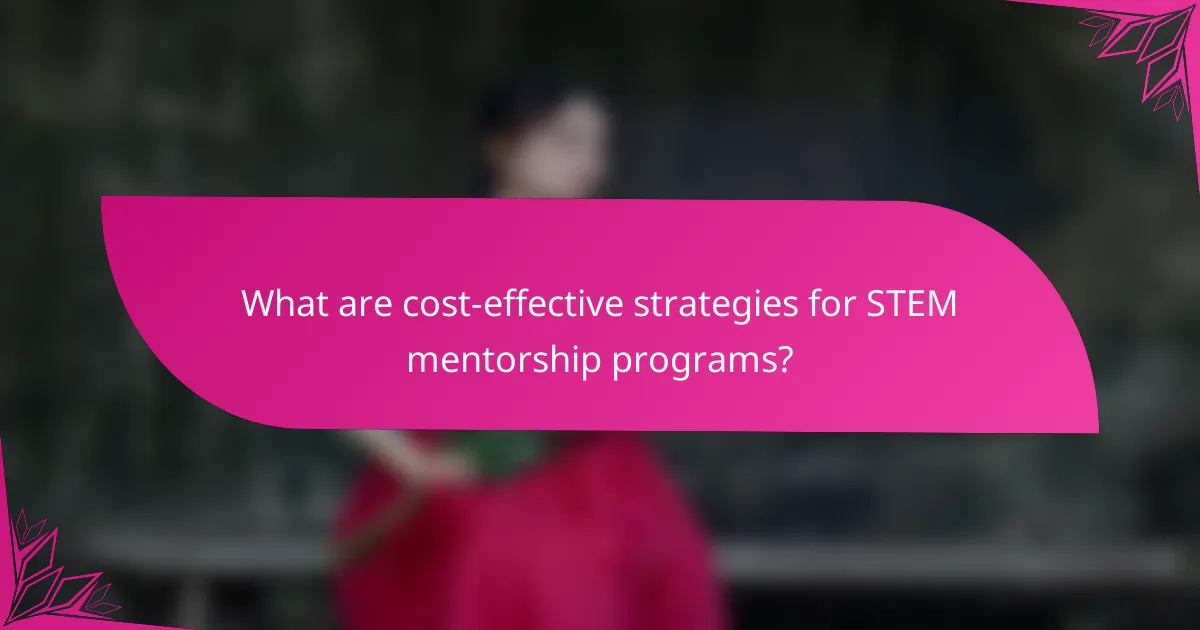
What are cost-effective strategies for STEM mentorship programs?
Cost-effective strategies for STEM mentorship programs focus on maximizing resources while providing meaningful guidance to mentees. These approaches include utilizing virtual platforms, partnering with local universities, and leveraging community resources to create impactful mentorship experiences without significant financial investment.
Utilizing virtual platforms
Virtual platforms offer an affordable way to connect mentors and mentees, eliminating geographical barriers and reducing travel costs. Tools like video conferencing and online collaboration software can facilitate regular meetings and resource sharing.
Consider using platforms such as Zoom or Microsoft Teams for meetings, and Google Drive or Slack for document sharing and communication. These tools are often free or low-cost, making them ideal for budget-conscious programs.
Partnering with local universities
Collaborating with local universities can enhance mentorship programs by tapping into existing resources and expertise. Universities often have outreach initiatives and may provide access to faculty, students, and facilities at little to no cost.
Establish partnerships by reaching out to university departments that align with your program’s focus. This can lead to guest lectures, workshops, and even student interns who can serve as mentors, enriching the experience for all participants.
Leveraging community resources
Community organizations, libraries, and non-profits can be valuable allies in developing STEM mentorship programs. These entities may offer free meeting spaces, promotional support, or access to local experts who can contribute to the program.
Identify and connect with local organizations that share similar goals. For instance, a local science museum might provide educational materials or host events, enhancing the mentorship experience while keeping costs low.

How can organizations implement STEM mentorship programs in urban areas?
Organizations can implement STEM mentorship programs in urban areas by focusing on community engagement and collaboration with local educational institutions and businesses. These programs should aim to connect students with mentors who can provide guidance, resources, and real-world experiences in science, technology, engineering, and mathematics fields.
Engaging local schools
To effectively engage local schools, organizations should first identify key educational partners that share a commitment to STEM education. Establishing relationships with teachers and administrators can facilitate program integration into existing curricula and after-school activities.
Offering workshops, guest lectures, and hands-on projects can spark student interest in STEM. Additionally, providing resources such as materials and technology can enhance the learning experience and ensure that students have access to the tools they need to succeed.
Creating partnerships with tech companies
Forming partnerships with tech companies can provide valuable resources and expertise for STEM mentorship programs. Companies can contribute by offering mentorship, internships, and real-world projects that align with students’ learning objectives.
Organizations should seek out local tech firms willing to invest in community development. This can include financial support, employee volunteer time, or access to facilities and equipment. Establishing a mutually beneficial relationship can enhance program sustainability and impact.
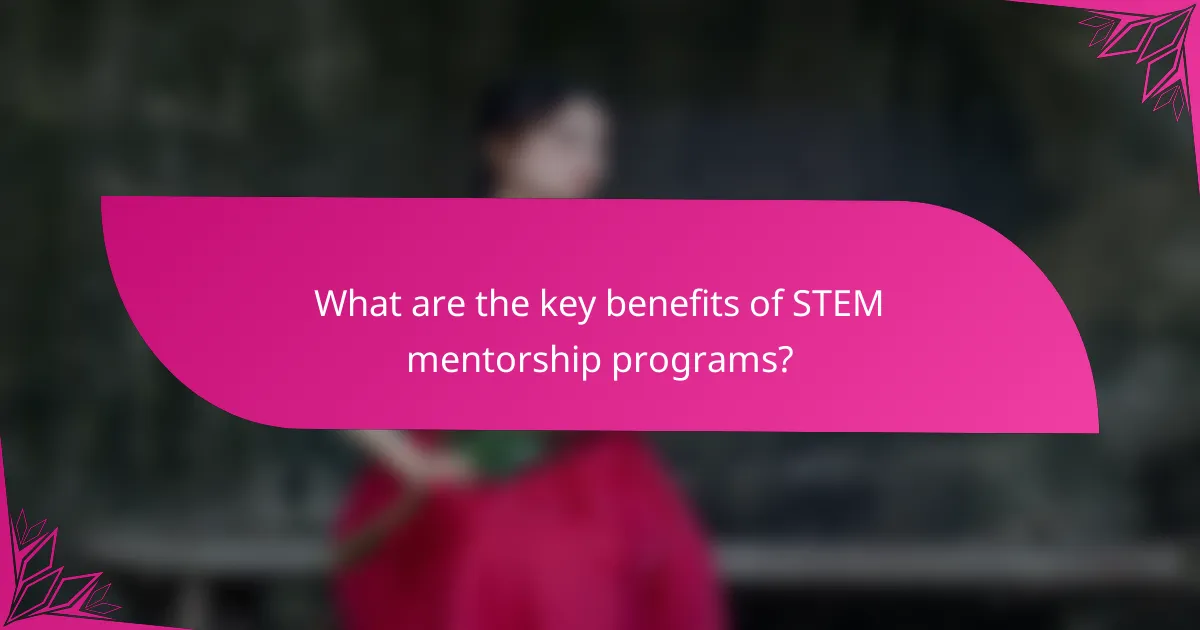
What are the key benefits of STEM mentorship programs?
STEM mentorship programs provide significant advantages for students, including increased engagement in science, technology, engineering, and mathematics fields, as well as improved career readiness. These programs connect students with experienced mentors who can guide them through academic and professional pathways.
Improved student engagement
STEM mentorship programs foster improved student engagement by creating a supportive environment where learners can explore their interests. Mentors often share real-world experiences, making the subjects more relatable and inspiring students to pursue STEM careers.
Active participation in mentorship can lead to higher retention rates in STEM courses. Programs that include hands-on projects or collaborative activities tend to keep students motivated and invested in their learning journey.
Enhanced career readiness
Mentorship in STEM fields significantly enhances career readiness by providing students with insights into various professions. Mentors can offer guidance on essential skills, industry expectations, and networking opportunities that are crucial for future employment.
Students involved in mentorship programs often gain access to internships or job shadowing experiences, which can be invaluable in building their resumes. Engaging with professionals helps students understand the job market and prepares them for successful transitions into the workforce.

What criteria should organizations consider when selecting mentors?
Organizations should prioritize relevant industry experience and strong communication skills when selecting mentors for STEM mentorship programs. These criteria ensure that mentors can provide valuable insights and effectively engage with mentees.
Relevant industry experience
Mentors with relevant industry experience bring practical knowledge and real-world applications to the mentorship relationship. This experience allows them to guide mentees through challenges and opportunities specific to their field.
When evaluating potential mentors, consider their years of experience, roles held, and projects completed in the STEM sector. For instance, a mentor with over five years in software development can offer insights into current technologies and best practices.
Strong communication skills
Effective communication is crucial for a successful mentorship. Mentors must be able to convey complex ideas clearly and engage mentees in meaningful discussions. This skill fosters a supportive environment where mentees feel comfortable asking questions.
Assess a mentor’s communication skills through their previous teaching or mentoring experiences. Look for individuals who have demonstrated the ability to explain concepts simply and encourage open dialogue. Role-playing scenarios or mock mentoring sessions can also help evaluate this skill.
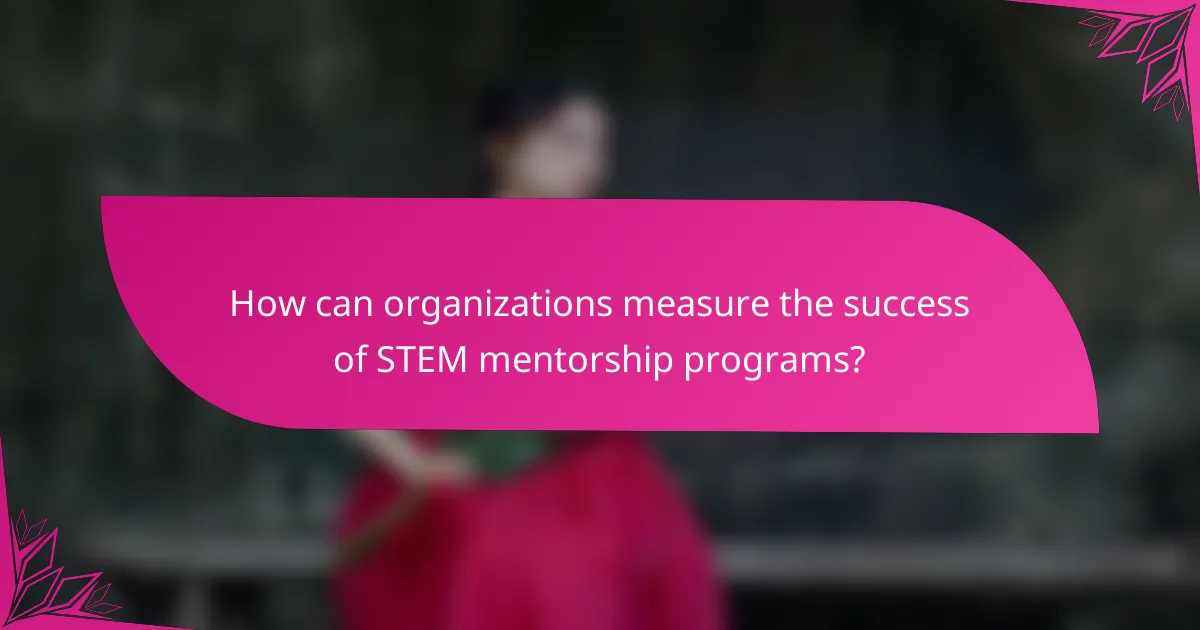
How can organizations measure the success of STEM mentorship programs?
Organizations can measure the success of STEM mentorship programs by evaluating participant outcomes and gathering feedback from mentees. These methods provide insights into the effectiveness of the program and areas for improvement.
Tracking participant outcomes
Tracking participant outcomes involves assessing both quantitative and qualitative metrics. Common metrics include academic performance, retention rates in STEM fields, and career advancement for mentees. Organizations can use surveys or performance data to gauge these outcomes over time.
For example, a program might track the percentage of mentees who pursue STEM degrees or secure internships within a year of participating. Establishing benchmarks before the program starts allows for meaningful comparisons later on.
Gathering feedback from mentees
Gathering feedback from mentees is crucial for understanding their experiences and perceived value of the mentorship. Regular surveys or focus groups can provide insights into what aspects of the program are working well and what needs adjustment.
Organizations should consider asking specific questions about the mentor-mentee relationship, skill development, and overall satisfaction. This feedback can help refine the program and ensure it meets the needs of participants effectively.
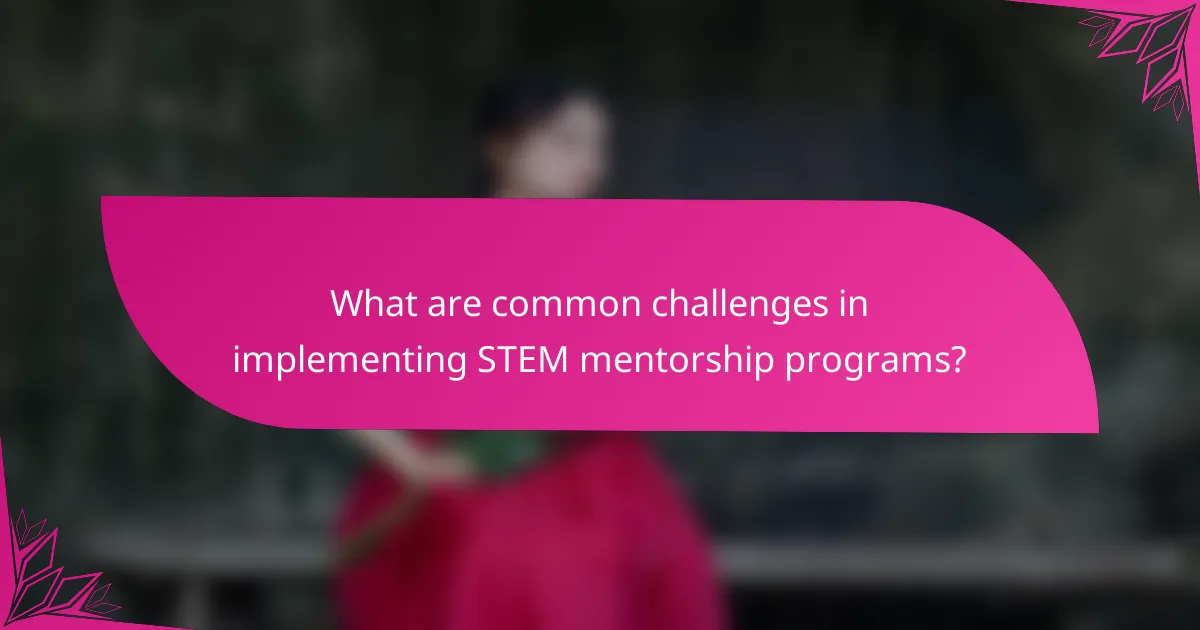
What are common challenges in implementing STEM mentorship programs?
Common challenges in implementing STEM mentorship programs include resource allocation and the recruitment of qualified mentors. Addressing these issues effectively can significantly enhance the success and sustainability of such programs.
Resource allocation
Resource allocation is crucial for the success of STEM mentorship programs. This includes budgeting for materials, training, and time commitments from both mentors and mentees. Organizations should consider a range of funding sources, such as grants, sponsorships, and partnerships with local businesses.
To optimize resource use, prioritize essential expenses and seek in-kind contributions, such as volunteer time or donated materials. Establishing a clear budget can help in tracking spending and ensuring that funds are directed towards impactful activities.
Recruitment of qualified mentors
Recruiting qualified mentors is a significant challenge that can impact the effectiveness of STEM mentorship programs. Potential mentors should possess relevant expertise and a passion for teaching, as well as the ability to engage and inspire students. Networking within local universities, industries, and professional organizations can help identify suitable candidates.
Consider creating a mentor training program to prepare volunteers for their roles. This can include workshops on effective communication and mentoring techniques, ensuring that mentors are well-equipped to provide valuable guidance to their mentees. Additionally, offering incentives such as professional development credits or recognition can enhance mentor recruitment efforts.
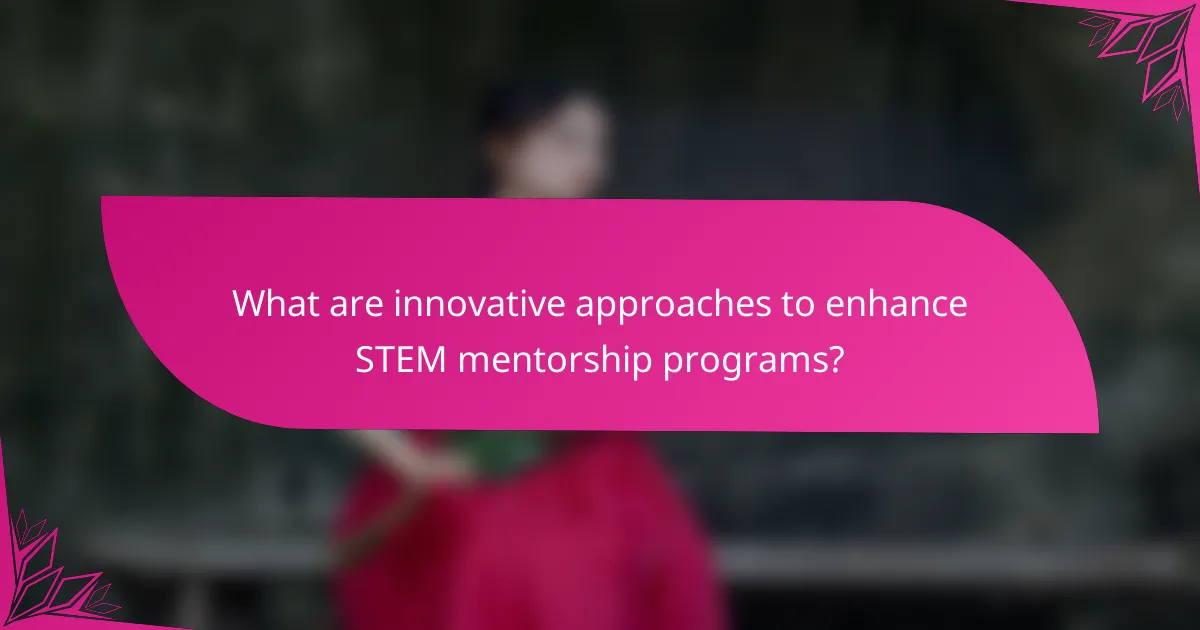
What are innovative approaches to enhance STEM mentorship programs?
Innovative approaches to enhance STEM mentorship programs focus on leveraging technology, community partnerships, and experiential learning. These strategies aim to create engaging, accessible, and effective mentorship experiences that can significantly benefit both mentors and mentees.
Utilizing Technology for Remote Mentorship
Technology can bridge geographical gaps, allowing mentors and mentees to connect regardless of location. Online platforms and tools such as video conferencing, collaborative workspaces, and educational apps facilitate real-time communication and resource sharing.
For effective remote mentorship, consider using platforms like Zoom or Microsoft Teams for meetings and Google Drive for document sharing. Ensure that both parties are comfortable with the technology to maximize engagement and productivity.
Building Community Partnerships
Establishing partnerships with local businesses, universities, and organizations can enrich STEM mentorship programs. These collaborations can provide resources, funding, and real-world experiences that enhance the learning process.
For example, a partnership with a local tech company could offer internships for mentees, while universities might provide access to research facilities. Engaging community stakeholders can also promote program visibility and attract more participants.
Incorporating Experiential Learning Opportunities
Experiential learning allows mentees to apply theoretical knowledge in practical settings, making STEM concepts more tangible. This could include hands-on projects, workshops, or field trips that align with the mentorship goals.
For instance, organizing a coding boot camp or a science fair can provide mentees with valuable skills and experiences. Ensure that these opportunities are relevant to the mentees’ interests to maintain motivation and engagement.
